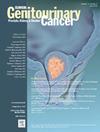Treatment Patterns and Outcomes in Lymph-Node-Positive (pN1) Prostate Cancer: A National Cancer Database Study
IF 2.7
3区 医学
Q3 ONCOLOGY
引用次数: 0
Abstract
Introduction
Lymph node involvement after radical prostatectomy (pN1) is associated with worse oncologic outcomes, yet its optimal management remains controversial. We evaluated oncologic outcomes and treatment patterns in pN1 prostate cancer.
Patients and Methods
We analyzed data from the National Cancer Database (NCDB) on men undergoing radical pN1 between 2010 and 2020. Exclusion criteria included distant metastases and delayed androgen-deprivation therapy (ADT) or adjuvant radiotherapy (aRT) beyond 1 year from surgery. The primary outcome was overall survival (OS). Multinomial logistic regression identified demographic and clinical predictors of treatment selection. Inverse probability of treatment weighting (IPTW) was applied to adjust baseline characteristics and perform weighted survival analysis across treatment groups.
Results
Among 13,454 patients with pN1 disease, 51.2% were managed with observation, 17.8% received ADT alone, 26.9% ADT plus aRT, and 4.1% aRT alone. Median follow-up was 56.3 months (IQR:36-83). ISUP grade 4-5, pT3-4 disease, and increased nodal burden were associated with treatment intensification. Compared to Non-Hispanic Whites, Non-Hispanic Black patients had lower odds of receiving ADT plus aRT (aOR: 0.79, 95% CI, 0.69-0.91, P < .001). ADT alone or aRT alone did not improve OS; ADT combined with aRT was significantly associated with improved OS (HR: 0.78, 95% CI, 0.68-0.89, P < .001).
Conclusion
This national analysis revealed variability in postsurgical management for pN1 disease. Only less than a third of men received aRT, despite this treatment being associated with improved OS. Given the observed variability in treatment use and outcomes, our findings support the value of individualized management strategies and multidisciplinary decision-making.
淋巴结阳性(pN1)前列腺癌的治疗模式和结果:一项国家癌症数据库研究。
导言:根治性前列腺切除术(pN1)后淋巴结累及与较差的肿瘤预后相关,但其最佳管理仍存在争议。我们评估了pN1前列腺癌的肿瘤预后和治疗模式。患者和方法:我们分析了国家癌症数据库(NCDB)中2010年至2020年间接受根治性pN1的男性的数据。排除标准包括远处转移和延迟雄激素剥夺治疗(ADT)或辅助放疗(aRT)手术后1年以上。主要终点是总生存期(OS)。多项逻辑回归确定了治疗选择的人口学和临床预测因素。应用治疗加权逆概率(IPTW)调整基线特征,并对各治疗组进行加权生存分析。结果:13454例pN1患者中,51.2%接受观察治疗,17.8%单独接受ADT治疗,26.9% ADT联合aRT治疗,4.1%单独接受aRT治疗。中位随访时间为56.3个月(IQR:36-83)。ISUP分级4-5级、pT3-4级疾病和淋巴结负担增加与强化治疗相关。与非西班牙裔白人相比,非西班牙裔黑人患者接受ADT + aRT的几率较低(aOR: 0.79, 95% CI: 0.69-0.91, P < 0.001)。单独ADT或单独aRT不能改善OS;ADT联合aRT与改善OS显著相关(HR: 0.78, 95% CI: 0.68-0.89, P < 0.001)。结论:这项全国性的分析揭示了pN1疾病的术后处理的可变性。只有不到三分之一的男性接受了aRT治疗,尽管这种治疗与改善OS有关。鉴于观察到的治疗使用和结果的可变性,我们的研究结果支持个性化管理策略和多学科决策的价值。
本文章由计算机程序翻译,如有差异,请以英文原文为准。
求助全文
约1分钟内获得全文
求助全文
来源期刊

Clinical genitourinary cancer
医学-泌尿学与肾脏学
CiteScore
5.20
自引率
6.20%
发文量
201
审稿时长
54 days
期刊介绍:
Clinical Genitourinary Cancer is a peer-reviewed journal that publishes original articles describing various aspects of clinical and translational research in genitourinary cancers. Clinical Genitourinary Cancer is devoted to articles on detection, diagnosis, prevention, and treatment of genitourinary cancers. The main emphasis is on recent scientific developments in all areas related to genitourinary malignancies. Specific areas of interest include clinical research and mechanistic approaches; drug sensitivity and resistance; gene and antisense therapy; pathology, markers, and prognostic indicators; chemoprevention strategies; multimodality therapy; and integration of various approaches.
 求助内容:
求助内容: 应助结果提醒方式:
应助结果提醒方式:


